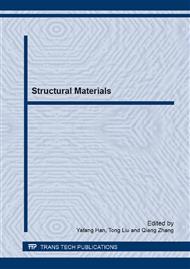[1]
Olson G B, Cohen M, A mechanism for the strain-induced nucleation of martensitic transformations[J], Journal of the Less Common Metals, 28(1972), 1, pp.107-118.
DOI: 10.1016/0022-5088(72)90173-7
Google Scholar
[2]
Tavares S S M, Gunderov D, Stolyarov V, et al. Phase transformation induced by severe plastic deformation in the AISI 304L stainless steel[J]. Materials Science and Engineering: A, 358(2003), 1–2, pp.32-36.
DOI: 10.1016/s0921-5093(03)00263-6
Google Scholar
[3]
Llewellyn D T. Work hardening effects in austenitic stainless steels[J]. 13(1997), 5, pp.389-400.
DOI: 10.1179/mst.1997.13.5.389
Google Scholar
[4]
Gonzalez B M, Castro C S B, Buono V T L, et al. The influence of copper addition on the formability of AISI 304 stainless steel[J]. Materials Science and Engineering: A, 343(2003), 1–2, pp.51-56.
DOI: 10.1016/s0921-5093(02)00362-3
Google Scholar
[5]
Rocha M R D, Oliveira C A S D. Evaluation of the martensitic transformations in austenitic stainless steels[J]. Materials Science and Engineering: A, 517(2009), 1–2,pp.281-285.
DOI: 10.1016/j.msea.2009.04.004
Google Scholar
[6]
Han H N, Lee C G, Oh C S, et al. A model for deformation behavior and mechanically induced martensitic transformation of metastable austenitic steel[J]. Acta Materialia, 52(2004), 17,pp.5203-5214.
DOI: 10.1016/j.actamat.2004.07.031
Google Scholar
[7]
Petit B, Gey N, Cherkaoui M, et al. Deformation behavior and microstructure/texture evolution of an annealed 304 AISI stainless steel sheet. Experimental and micromechanical modeling[J], International Journal of Plasticity, 23(2007), 2, pp.323-341.
DOI: 10.1016/j.ijplas.2006.07.002
Google Scholar
[8]
Delogu F. A few details of the austenite to martensite phase transformation in 304 stainless steel powders under mechanical processing[J]. Acta Materialia, 59(2011), 5, pp.2069-2074.
DOI: 10.1016/j.actamat.2010.12.007
Google Scholar
[9]
Haušild P, Davydov V, Drahokoupil J, et al. Characterization of strain-induced martensitic transformation in a metastable austenitic stainless steel[J]. Materials & Design, 31(2010), 4, pp.1821-1827.
DOI: 10.1016/j.matdes.2009.11.008
Google Scholar
[10]
Choi J Y, Jin W. Strain Induced Martensite Formation and its Effect on Strain Hardening Behavior in Cold Drawn AISI 304 Austenitic Stainless Steel[J]. 36(1997), 01,p.99.
DOI: 10.1016/s1359-6462(96)00338-7
Google Scholar
[11]
Tavares S S M, Pardal J M, Da Silva M J G, et al. Deformation induced martensitic transformation in a 201 modified austenitic stainless steel[J]. Materials Characterization, 60(2009), 8, pp.907-911.
DOI: 10.1016/j.matchar.2009.02.001
Google Scholar
[12]
Talonen J, Hanninen H. Damping Properties of Austenitic Stainless Steels Containing Strain-Induced Martensite[J]. 35A(2004), 8, pp.2401-2406.
DOI: 10.1007/s11661-006-0220-x
Google Scholar
[13]
Milad M, Zreiba N, Elhalouani F, et al. The effect of cold work on structure and properties of AISI 304 stainless steel[J]. Journal of Materials Processing Technology, 203(2008), 1–3,pp.80-85.
DOI: 10.1016/j.jmatprotec.2007.09.080
Google Scholar
[14]
Lebedev A A, Kosarchuk V V. Influence of phase transformations on the mechanical properties of austenitic stainless steels[J]. International Journal of Plasticity, 16(2000), 7–8, pp.749-767.
DOI: 10.1016/s0749-6419(99)00085-6
Google Scholar
[15]
Das A, Tarafder S. Experimental investigation on martensitic transformation and fracture morphologies of austenitic stainless steel[J], International Journal of Plasticity, 25(2009), 11, pp.2222-2247.
DOI: 10.1016/j.ijplas.2009.03.003
Google Scholar
[16]
Tsakiris V, Edmonds D V. Martensite and deformation twinning in austenitic steels[J]. Materials Science and Engineering: A, 273–275(1999)430-436.
DOI: 10.1016/s0921-5093(99)00322-6
Google Scholar
[17]
Ktari Z, Tourki Z, Sidhom H, et al. On the interaction between transformation induced plasticity and the austenitic stainless steel anisotropy (AISI 304) under shear loading path[J]. Materials & Design, 32(2011), 7, pp.3765-3771.
DOI: 10.1016/j.matdes.2011.03.043
Google Scholar
[18]
Murr L E, Staudhammer K P, Hecker S S. Effects of strain state and strain rate on deformation induced transformation in 304 stainless steel: part 1. Magnetic measurements and mechanical behavior[J]. 13(1982)619-626.
DOI: 10.1007/bf02644427
Google Scholar


